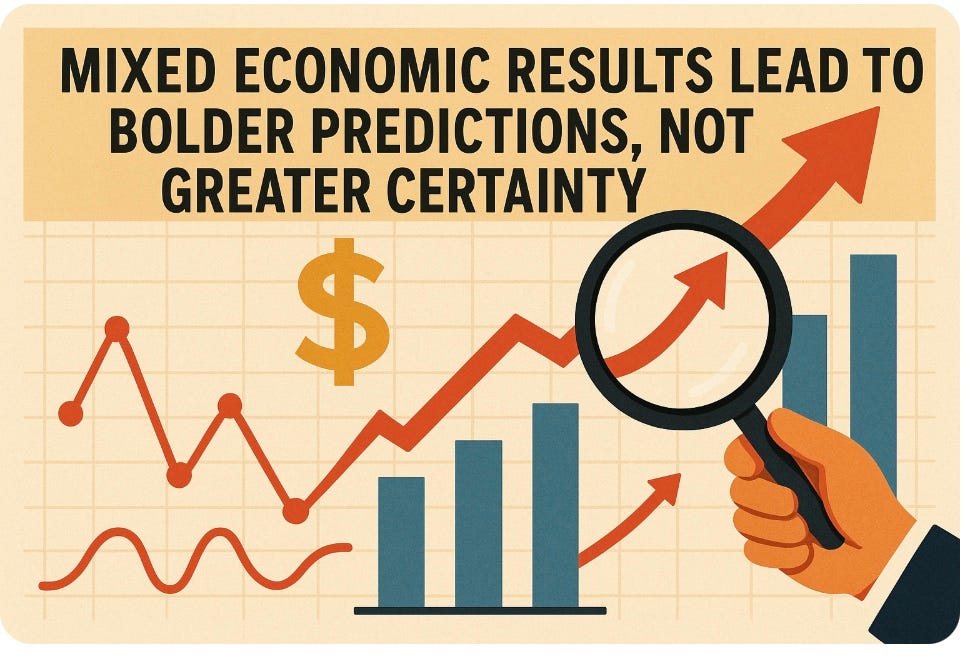Mixed Economic Signals & Bolder Forecasts
Positive outlooks being derived from recent economic data is overly optimistic
The week of June 14-20 brought contradictory economic signals that left analysts scratching their heads. Consumer sentiment jumped 16% while retail sales plunged 0.9%. The Federal Reserve held rates steady while warning of stagflation risks. Markets rallied while recession probabilities hit 45-60%.
The disconnect makes more sense when you examine what's happening in restaurants—America's most reliable economic bellwether.
The Numbers Don't Match the Headlines
Consumer sentiment's surge to 60.5 suggests Americans feel better about the economy. But restaurant traffic tells a different story. Traffic dropped 3.0% industry-wide in Q1, with Black Box Intelligence reporting 15 negative months out of the last 17. Same-store sales growth slowed to just 0.3%, down from 0.9% in Q4 2024.
This isn't random noise. Restaurants capture discretionary spending patterns better than most economic indicators because dining out represents the first expense consumers cut when uncertainty hits.
The Federal Reserve acknowledged this reality when Chair Powell warned that "everyone that I know is forecasting a meaningful increase in inflation in coming months from tariffs because someone has to pay for the tariffs." Restaurant operators are living this prediction daily, caught between rising costs and consumer resistance to higher prices.
The Real Story: Selective Spending, Not Broad Recovery
The restaurant data reveals what aggregate consumer confidence numbers miss: Americans haven't stopped spending—they've become ruthlessly selective.
Taco Bell posted +9% same-store sales with positive traffic across all income levels. McDonald's declined 3.6% despite $5 meal deals. The difference isn't price alone—it's perceived value. Black Box Intelligence found restaurants with positive traffic score 6 percentage points higher on value sentiment.
This mirrors broader retail patterns documented in May retail sales data (US Census Bureau Spending
). The 0.9% retail sales decline hit motor vehicles (-3.5%), home improvement (-2.7%), and even restaurants (-0.9%). But e-commerce continued growing at 8.3% annually, with nonstore retailers now capturing 30% of electronics sales. Consumers are spending—just differently.
Three Forces Reshaping Consumer Behavior
Value Wars Are Real: Twenty of the top 50 restaurant chains now offer value meals, fundamentally shifting expectations. This reflects what the University of Michigan found: one-year inflation expectations dropped to 5.1% from 6.6%, suggesting consumers believe tariff-driven price increases may moderate.
Technology Drives Operational Excellence: The winning operators aren't just digitizing orders—they're using technology to improve experiences and make better decisions. This operational advantage helps explain why some restaurants thrive while others struggle in the same challenging environment.
Geographic Divergence Widens: New England posts positive restaurant traffic growth while California declined 8 straight months. This pattern extends beyond restaurants—regional economic performance increasingly varies based on local policy and demographic factors.
The Sustainability Question
Restaurant industry projections call for $1.5 trillion in 2025 revenue, but real growth (after inflation) sits at just 0.3%. Translation: operators maintain revenue by raising prices on a shrinking customer base.
This isn't sustainable, and it mirrors broader economic concerns. Total household debt reached $18.20 trillion in Q1 2025, with delinquencies rising to 4.3% from 3.6%. Student loan delinquencies spiked to 7.74% as pandemic protections ended. The personal savings rate edged up to 4.9% but remains well below healthy levels.
Financial stress shows up first in restaurant spending because dining out requires both disposable income and consumer confidence. The current pattern—flat traffic despite promotional pricing—suggests Americans are managing their finances more carefully than sentiment surveys indicate.
What This Means Going Forward
The restaurant industry's mixed signals actually make perfect sense given current economic conditions. NPD Group reports 54% of Americans plan to dine out more in 2025, led by Gen Z (71%) and Millennials (68%). But planning and executing are different things when facing tariff uncertainty and elevated debt levels.
The Federal Reserve faces an increasingly complex challenge: fighting inflation expectations while supporting an economy showing clear deceleration signs. Restaurant performance suggests consumers are already adjusting to this reality—maintaining some discretionary spending while becoming more value-conscious.
As one industry veteran put it: "Flat is the new up." In an environment where 15,000 store closures are projected for 2025—the first time closures outpace openings—survival represents victory. These closures might help same-store sales in over-saturated markets, but that's not an indicator of industry health.
The restaurant industry isn't just reflecting broader economic trends—it's previewing them. When Americans become more selective about their $15 lunch choices, they're signaling deeper concerns about their financial future. Consumer confidence surveys capture how people feel. Restaurant traffic shows how they actually behave.
Right now, behavior suggests the economic recovery isn't as solid as the headlines suggest.





